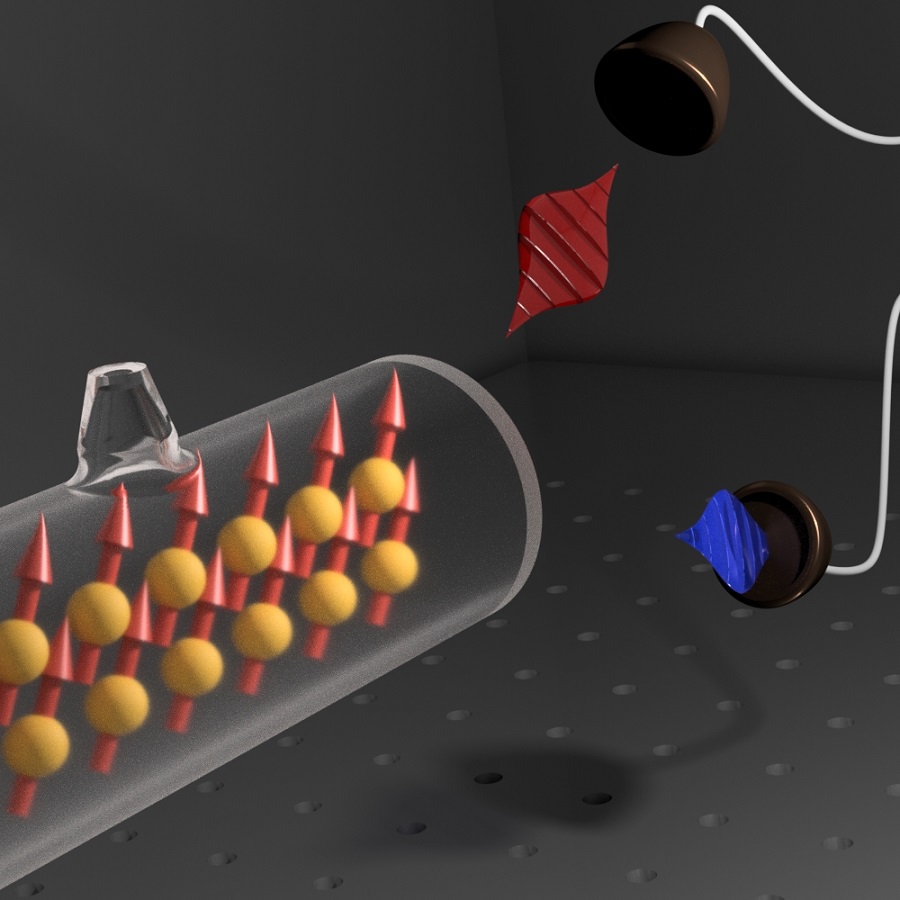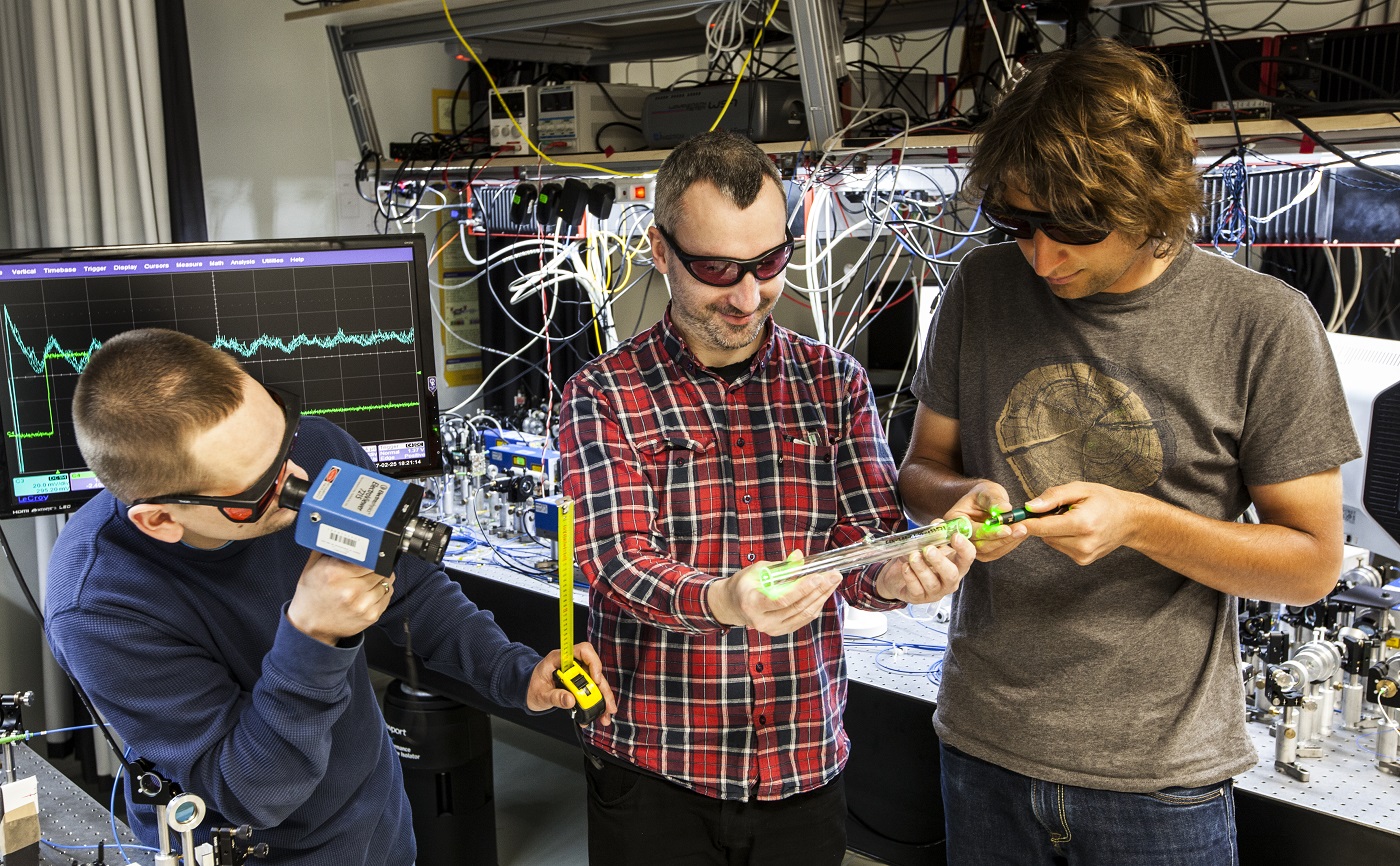1 March 2017
New light is shed on the famous paradox of Einstein, Podolsky and Rosen after 80 years. A group of researchers from the Faculty of Physics at the University of Warsaw has created a multidimensional entangled state of a single photon and a trillion of hot rubidium atoms. This hybrid entanglement has been stored in the laboratory for several microseconds. The research has been published in the prestigious Optica journal.
In their famous Physical Review article published in 1935, A. Einstein, B. Podolsky and N. Rosen have considered a decay of a particle into two products. In their thought-experiment, two products of decay were projected in exactly opposite directions, or more scientifically speaking their momenta were anti-correlated. It would not be a mystery within the framework of classical physics, however when applying the rules of the Quantum theory, the three researchers quickly arrived at a paradox. The Heisenberg uncertainty principle, dictating that position and momentum of a particle cannot be measured at the same time within arbitrary precision, lies at the center of this paradox. In Einstein’s thought-experiment one can measure momentum of one particle and immediately know momentum of the other without measurement, as it is exactly opposite. Then, one only needs to measure position of this second particle and the Heisenberg uncertainty principle seems to be violated, which seriously baffled the three physicists.
Only today we know that this experiment is not, in fact, a paradox. The mistake of Einstein and co-workers was to use one-particle uncertainty principle to a system of two particles. If we treat these two particles as described by a single quantum state, we learn that the original uncertainty principle ceases to apply, especially if these particles are entangled.
In the Quantum Memories Laboratory at the University of Warsaw, the group of three physicists was first to create such an entangled state consisting of a macroscopic object - a group of about one trillion atoms, and a single photon - a particle of light. “Single photons, scattered during the interaction of a laser beam with atoms, are registered on a sensitive camera. A single registered photon carries information about the quantum state of the entire group of atoms. The atoms may be stored, and their state may be retrieved on demand.” - says Michal Dabrowski, PhD student and co-author of the article.
The results of the experiment confirm that the atoms and the single photon are in a joint, entangled state. By measuring position and momentum of the photon, we gain all information about the state of atoms. To confirm this, polish scientists convert the atomic state into another photon, which again is measured using the state-of-the-art camera developed in the Quantum Memories Laboratory. “We demonstrate the Einstein-Podolsky-Rosen apparent paradox in a very similar version as originally proposed in 1935, however we extend the experiment by adding storage of light within the large group of atoms. Atoms store the photon in a form of a wave made of atomic spins, containing one trillion atoms. Such a state is very robust against loss of a single atoms, as information is spread across so many particles.” - says Michal Parniak, PhD student taking part in the study.

Visualization of a hybrid bipartite entanglement between a single photon (blue) and an atomic spin-wave excitation inside quantum memory glass cell, subsequently confirmed in the detection process of a second photon (red). Presented setup enables the demonstration of Einstein-Podolsky-Rosen paradox with true positions and momenta. (Source: UW Physics, Michal Dabrowski)
The experiment performed by the group from the University of Warsaw is unique in one other way as well. The quantum memory storing the entangled state, created thanks to “PRELUDIUM” grant from the National Science Centre and “Diamentowy Grant” from the Polish Ministry of Science and Higher Education, allows for storage of up to 12 photons at once. This enhanced capacity is promising in terms of applications in quantum information processing. “The multidimensional entanglement is stored in our device for several microseconds, which is roughly a thousand times longer than in any previous experiments, and at the same time long enough to perform subtle quantum operations on the atomic state during storage” - explains Dr. Wojciech Wasilewski, group leader of the Quantum Memories Laboratory team.
The entanglement in the real and momentum space, described in the Optica article, can be used jointly with other well-known degrees of freedom such as polarization, allowing generation of so-called hyper-entanglement. Such elaborate ideas constitute new and original test of the fundamentals of quantum mechanics - a theory that is unceasingly mysterious yet brings immense technological progress.
Physics and Astronomy first appeared at the University of Warsaw in 1816, under the then Faculty of Philosophy. In 1825 the Astronomical Observatory was established. Currently, the Faculty of Physics' Institutes include Experimental Physics, Theoretical Physics, Geophysics, Department of Mathematical Methods and an Astronomical Observatory. Research covers almost all areas of modern physics, on scales from the quantum to the cosmological. The Faculty's research and teaching staff includes ca. 200 university teachers, of which 88 are employees with the title of professor. The Faculty of Physics, University of Warsaw, is attended by ca. 1000 students and more than 170 doctoral students.
SCIENTIFIC PAPERS:
“Einstein-Podolsky-Rosen paradox in a hybrid bipartite system”
M. Dąbrowski, M. Parniak, W. Wasilewski
Optica 4, 272-275 (2017); DOI: 10.1364/OPTICA.4.000272













